
|
It brightened up to 6.2 mag in June (June 24, Marco Goiato). Now it is fading. It has already faded down to 8.6 mag (July 28, Marco Goiato). It is observable in excellent condition in the Southern Hemisphere. In the Northern Hemisphere, it locates low in the south.
Date(TT) R.A. (2000) Decl. Delta r Elong. m1 Best Time(A, h)
July 30 14 30.73 -33 16.3 1.523 1.953 98 8.8 18:44 ( 97, 80)
Aug. 6 14 23.57 -31 29.3 1.747 2.023 90 9.3 18:48 ( 95, 72)
|

|
Now it is 13.4 mag (July 3, Ken-ichi Kadota). It will brighten up to 11 mag from summer to autumn. Now it is appearing in the morning sky, but it keeps low for some time.
Date(TT) R.A. (2000) Decl. Delta r Elong. m1 Best Time(A, h)
July 30 6 4.86 24 15.7 2.065 1.378 35 11.4 5:28 (234, 7)
Aug. 6 6 30.53 23 5.5 2.038 1.367 36 11.4 5:23 (235, 7)
|
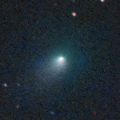
|
Now it is 12.0 mag (July 28, Chris Wyatt). It keeps 11-12 mag until September. In the Northern Hemisphere, it will be getting lower gradually after this. In the Southern Hemisphere, it keeps observable in good condition for a long time.
Date(TT) R.A. (2000) Decl. Delta r Elong. m1 Best Time(A, h)
July 30 13 35.76 -9 18.7 1.381 1.543 78 11.4 18:44 (132, 56)
Aug. 6 13 52.53 -11 50.5 1.421 1.543 76 11.5 18:48 (124, 55)
|

|
Now it is 11.2 mag (July 28, Chris Wyatt). It is not observable now in the Northern Hemisphere. It locates low, but it keeps observable until August in the Southern Hemisphere.
Date(TT) R.A. (2000) Decl. Delta r Elong. m1 Best Time(A, h)
July 30 10 56.74 8 31.3 2.314 1.595 35 11.9 18:44 (112, 15)
Aug. 6 11 16.16 6 36.0 2.343 1.601 33 12.0 18:48 (108, 14)
|

|
It became so bright as 8 mag in 2009. Appearing in the morning sky. In the Northern Hemispehre, it will be observable at 11-12 mag from summer to autumn. In the Southern Hemisphere, it keeps extremely low for a long time until autumn. Now it is 15.2 mag (Aug. 1, Jean-Francois Soulier), fainter than this ephemeris.
Date(TT) R.A. (2000) Decl. Delta r Elong. m1 Best Time(A, h)
July 30 6 34.94 22 35.3 2.280 1.477 28 12.3 5:28 (240, 3)
Aug. 6 6 59.55 21 54.1 2.247 1.459 29 11.9 5:23 (240, 3)
|

|
It brightened up to 8-9 mag from winter to spring. Now it is fading. It has already faded down to 12.9 mag (July 23, Chris Wyatt). In the Northern Hemisphere, it will be getting lower gradually and will be unobservable in August. It is observable in the evening sky also in the Southern Hemisphere until August.
Date(TT) R.A. (2000) Decl. Delta r Elong. m1 Best Time(A, h)
July 30 11 38.93 15 50.2 4.019 3.352 43 12.4 18:44 (125, 18)
Aug. 6 11 44.45 14 4.2 4.143 3.409 38 12.5 18:48 (119, 14)
|
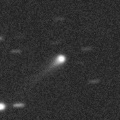
|
It brightened rapidly up to 13.7 mag (July 28, Chris Wyatt). It will be observable at 12-13 mag until autumn.
Date(TT) R.A. (2000) Decl. Delta r Elong. m1 Best Time(A, h)
July 30 13 54.23 -13 9.8 1.911 2.070 84 13.1 18:44 (134, 61)
Aug. 6 14 5.93 -13 25.2 1.968 2.055 80 12.9 18:48 (127, 58)
|

|
Now it is 13.5 mag (July 28, Chris Wyatt). It will be fading gradually after August. In the Northern Hemisphere, it keeps observable until early November. It becomes observable in the evening sky from July to September also in the Southern Hemisphere.
Date(TT) R.A. (2000) Decl. Delta r Elong. m1 Best Time(A, h)
July 30 15 8.58 40 12.6 2.986 3.048 83 13.2 18:44 (178, 15)
Aug. 6 15 9.52 36 41.6 3.074 3.083 81 13.3 18:48 (172, 18)
|

|
Outburst occured on July 28, and it brightened up to 13.1 mag (July 28, Chris Wyatt). It is observable in excellent condition in the Southern Hemisphere.
Date(TT) R.A. (2000) Decl. Delta r Elong. m1 Best Time(A, h)
July 30 19 27.41 -25 48.2 4.942 5.917 162 13.3 22:53 (180, 81)
Aug. 6 19 24.23 -25 47.3 4.980 5.915 154 13.3 22:22 (180, 81)
|

|
It will brighten up to 13 mag in summer. But it keeps unobservable for a long time. It will appear in the morning sky in December, when the comet will be fainter than 15 mag.
Date(TT) R.A. (2000) Decl. Delta r Elong. m1 Best Time(A, h)
July 30 8 19.88 12 45.9 2.474 1.472 7 13.6 5:28 (262,-11)
Aug. 6 8 43.65 11 13.8 2.447 1.447 7 13.5 5:23 (264,-11)
|
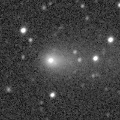
|
Now it is bright as 13.5 mag (July 28, Chris Wyatt). It will be observable at 13 mag in good condition from spring to summer.
Date(TT) R.A. (2000) Decl. Delta r Elong. m1 Best Time(A, h)
July 30 21 6.58 -13 12.7 1.530 2.538 171 14.0 0:36 (180, 68)
Aug. 6 21 2.96 -13 52.5 1.541 2.555 177 14.0 0:05 (180, 69)
|

|
It brightened up to 6 mag from autumn to winter. Now it is fading. It has already faded down to 13.9 mag (July 14, Katsumi Yoshimoto). In the Northern Hemisphere, it will be getting higher in the morning sky. It is not observable after this in the Southern Hemisphere.
Date(TT) R.A. (2000) Decl. Delta r Elong. m1 Best Time(A, h)
July 30 5 58.42 48 36.0 4.463 3.798 43 14.0 5:28 (215, -9)
Aug. 6 6 1.30 49 4.6 4.462 3.875 49 14.1 5:23 (213, -7)
|

|
Now it is 14.3 mag (July 3, Alan Hale). Distant object, but it keeps observable at 14-15 mag for a long time from 2015 to 2016.
Date(TT) R.A. (2000) Decl. Delta r Elong. m1 Best Time(A, h)
July 30 0 50.38 2 1.7 4.395 4.905 114 14.1 4:19 (180, 53)
Aug. 6 0 51.56 1 44.2 4.309 4.911 121 14.1 3:53 (180, 53)
|
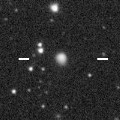
|
Now it is 14.2 mag (July 23, Artyom Novichonok). It is expected to brighten up to 7 mag in 2017 summer. In the Northern Hemisphere, it becomes low temporarily in summer, but it keeps observable in good condition until the highlight while the comet will be brightening. In the Southern Hemisphere, it is not observable until early 2017.
Date(TT) R.A. (2000) Decl. Delta r Elong. m1 Best Time(A, h)
July 30 9 12.58 52 59.5 4.894 4.106 35 14.6 18:44 (137,-28)
Aug. 6 9 25.35 52 30.1 4.816 4.040 36 14.5 18:48 (135,-30)
|

|
It is not observable now. It will be observable at 16.5 mag in September in the Northern Hemisphere, or in November in the Southern Hemisphere.
Date(TT) R.A. (2000) Decl. Delta r Elong. m1 Best Time(A, h)
July 30 7 54.50 17 8.2 3.000 2.010 10 14.6 5:28 (255, -9)
Aug. 6 8 11.45 16 30.0 2.996 2.020 12 14.7 5:23 (255, -7)
|

|
It passes the perihelion on Aug. 19. It is not observable now. In the Northern Hemisphere, it will be observable at 15 mag in good condition from September to October. In the Southern Hemisphere, it is not observable until November.
Date(TT) R.A. (2000) Decl. Delta r Elong. m1 Best Time(A, h)
July 30 7 43.85 19 44.3 1.608 0.658 12 15.4 5:28 (251, -8)
Aug. 6 8 24.33 16 38.1 1.461 0.492 9 14.6 5:23 (256,-10)
|
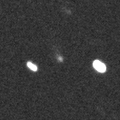
|
Now it is bright as 14.9 mag (May 4, Hidetaka Sato). It keeps 15 mag until autumn. In the Southern Hemisphere, it keeps observable for a long time. It will be unobservable after this in the Northern Hemisphere.
Date(TT) R.A. (2000) Decl. Delta r Elong. m1 Best Time(A, h)
July 30 8 37.49 -54 30.7 2.427 2.342 73 15.0 5:28 (322, 23)
Aug. 6 9 11.96 -56 2.5 2.451 2.358 72 15.0 18:48 ( 37, 24)
|

|
Now it is 15.5 mag (July 5, Hidetaka Sato). It will brighten up to 14 mag in summer. It is observable in excellent condition in the Northern Hemispehre. In the Southern Hemisphere, it keeps locating low until August, but it will be observable in good condition after September.
Date(TT) R.A. (2000) Decl. Delta r Elong. m1 Best Time(A, h)
July 30 0 45.59 45 32.4 1.545 1.920 94 15.3 4:15 (180, 9)
Aug. 6 0 12.07 46 4.7 1.380 1.905 104 15.0 3:15 (180, 9)
|
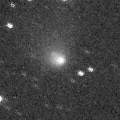
|
Now it is 14.2 mag (July 2, Chris Wyatt). In the Northern Hemisphere, it will be unobservable soon. In the Southern Hemisphere, it keeps observable in good condition until autumn. But it will be fading slowly after this.
Date(TT) R.A. (2000) Decl. Delta r Elong. m1 Best Time(A, h)
July 30 13 16.95 -25 35.8 2.334 2.394 80 15.3 18:44 (102, 63)
Aug. 6 13 26.78 -26 41.2 2.421 2.404 76 15.4 18:48 ( 95, 59)
|
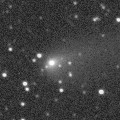
|
Now it is 13.9 mag (July 2, Chris Wyatt). It will be fading gradually after this. It is observable in excellent condition in the Southern Hemisphere. But it locates somewhat low in the Northern Hemisphere.
Date(TT) R.A. (2000) Decl. Delta r Elong. m1 Best Time(A, h)
July 30 15 31.34 -22 57.8 2.061 2.577 109 15.3 18:58 (180, 78)
Aug. 6 15 37.23 -23 12.7 2.166 2.601 103 15.6 18:48 (167, 78)
|

|
Now it is 15.4 mag (July 3, Hidetaka Sato), brighter than originally predicted. Now it is brightest. In the Southern Hemisphere, it keeps observable until winter, but it locates somewhat low. In the Northern Hemisphere, it will be getting higher after this, and it will be observable in excellent condition.
Date(TT) R.A. (2000) Decl. Delta r Elong. m1 Best Time(A, h)
July 30 4 36.21 15 2.0 1.738 1.471 57 15.4 5:28 (223, 28)
Aug. 6 4 54.53 17 0.4 1.721 1.492 59 15.5 5:23 (221, 27)
|
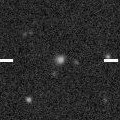
|
Now it is 16.6 mag (June 29, MASTER-SAAO Observatory). It will be unobservable temporarily from summer to autumn. Then it will appear in the morning sky at 13 mag in December. It is expected to brighten up to 7 mag in 2017 spring. But it locates somewhat low at the high light.
Date(TT) R.A. (2000) Decl. Delta r Elong. m1 Best Time(A, h)
July 30 11 32.29 -1 36.2 4.581 3.964 47 15.8 18:44 (110, 28)
Aug. 6 11 37.78 -2 3.9 4.583 3.891 42 15.7 18:48 (105, 23)
|
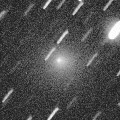
|
It brightened up to 10-11 mag in May. Now it is fading rapidly. It has already faded down to 15.8 mag (July 9, Ken-ichi Kadota). It keeps observable in good condition until September.
Date(TT) R.A. (2000) Decl. Delta r Elong. m1 Best Time(A, h)
July 30 15 12.25 19 54.4 1.719 2.019 91 15.8 18:44 (178, 35)
Aug. 6 15 4.71 15 39.2 1.904 2.087 85 16.4 18:48 (166, 39)
|
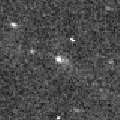
|
First return of a new periodic comet which brightened up to 16.5 mag in 2008. The condition of this apparition is very good. It is expected to brighten up to 15.5 mag in autumn and will be observable in good condition. Now it is 18.8 mag (July 3, E. Schwab, D. Abreu), fainter than predicted by 2 mag.
Date(TT) R.A. (2000) Decl. Delta r Elong. m1 Best Time(A, h)
July 30 0 30.39 -17 35.2 1.718 2.446 124 16.1 3:59 (180, 73)
Aug. 6 0 30.08 -17 11.8 1.640 2.430 131 16.0 3:32 (180, 72)
|
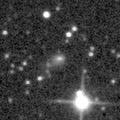
|
Now it is 16.8 mag (June 25, Alexander Baransky). It will be observable at 13 mag for a long time from 2017 to 2018. In 2016, it keeps observable at 16-17 mag in good condition until autumn.
Date(TT) R.A. (2000) Decl. Delta r Elong. m1 Best Time(A, h)
July 30 19 15.97 -10 13.1 5.125 6.081 158 16.2 22:41 (180, 65)
Aug. 6 19 9.20 -10 2.8 5.130 6.038 151 16.2 22:07 (180, 65)
|

|
Now it is 16.2 mag (June 29, iTelescope Observatory, Siding Spring). It keeps 16 mag for a long time from 2016 to 2017. In 2016, it is observable in excellent condition in the Southern Hemisphere, but it locates extremely low in the Northern Hemispehre.
Date(TT) R.A. (2000) Decl. Delta r Elong. m1 Best Time(A, h)
July 30 12 52.68 -22 27.6 3.557 3.429 74 16.5 18:44 (102, 56)
Aug. 6 13 1.11 -21 43.2 3.627 3.406 69 16.4 18:48 ( 99, 51)
|
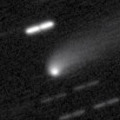
|
It brightened very rapidly in 2015 spring, and reached up to 13.8 mag (2015 May 11, Sandor Szabo). Now it is 15.7 mag (June 7, Yasukazu Ikari). In the Northern Hemisphere, it will be unobservable in August. In the Southern Hemisphere, it keeps observable until October, but it will be fading.
Date(TT) R.A. (2000) Decl. Delta r Elong. m1 Best Time(A, h)
July 30 13 56.77 -24 42.2 4.415 4.510 88 16.5 18:44 (115, 70)
Aug. 6 14 1.39 -24 44.0 4.547 4.541 83 16.6 18:48 (106, 65)
|
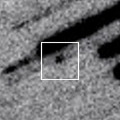
|
Now it is 16.2 mag (July 5, Hidetaka Sato). It will be observable at 16 mag in good condition from autumn to winter. It locates somewhat low in the Southern Hemisphere.
Date(TT) R.A. (2000) Decl. Delta r Elong. m1 Best Time(A, h)
July 30 3 29.00 24 48.3 2.648 2.510 71 16.6 5:28 (203, 27)
Aug. 6 3 39.80 25 46.8 2.573 2.513 75 16.6 5:23 (200, 26)
|

|
Now it is 16.1 mag (July 7, Kunihiro Shima). It keeps 16.5 mag from 2016 to 2017. It is observable in good condition in the Northern Hemisphere. In the Southern Hemisphere, it locates low in 2016, and it is not observable in 2017.
Date(TT) R.A. (2000) Decl. Delta r Elong. m1 Best Time(A, h)
July 30 16 34.89 35 32.6 6.037 6.312 101 16.7 20:01 (180, 19)
Aug. 6 16 33.14 35 22.4 6.095 6.305 97 16.7 19:32 (180, 20)
|

|
New comet. Now it is 16.2 mag (July 16, G. Borisov, A. Novichonok).
Date(TT) R.A. (2000) Decl. Delta r Elong. m1 Best Time(A, h)
July 30 0 25.23 -18 8.3 4.011 4.684 126 16.7 3:54 (180, 73)
Aug. 6 0 21.70 -18 7.1 3.978 4.730 133 16.7 3:23 (180, 73)
|

|
Now it is 17.1 mag (June 14, Mt. Lemmon Survey). It will brighten up to 16.5 mag in summer and will be observable in good condition.
Date(TT) R.A. (2000) Decl. Delta r Elong. m1 Best Time(A, h)
July 30 17 35.44 -10 56.0 1.889 2.707 135 16.7 21:02 (180, 66)
Aug. 6 17 34.14 -10 59.3 1.934 2.687 128 16.7 20:33 (180, 66)
|

|
Now it is 17.1 mag (July 3, Hidetaka Sato). It had been lost for a long time over 200 years since its discovery in 1783. The condition of this apparition is excellent, and it will brighten up to 15 mag in autumn. In the Northern Hemisphere, it will be getting higher rapidly after this, and will be observable in excellent condition from summer to winter. In the Southern Hemisphere, it keeps observable in good condition until November.
Date(TT) R.A. (2000) Decl. Delta r Elong. m1 Best Time(A, h)
July 30 4 10.12 -3 19.3 1.899 1.810 69 17.0 5:28 (231, 46)
Aug. 6 4 21.55 -1 26.4 1.830 1.799 72 16.9 5:23 (226, 46)
|

|
It brightened up to 15 mag from late 2014 to early 2016. Now it is fading slowly. Now it is 16.6 mag (June 16, Catalina Sky Survey). In the Northern Hemisphere, it will be observable at 17 mag in autumn in good condition. It locates extremely low in the Southern Hemisphere.
Date(TT) R.A. (2000) Decl. Delta r Elong. m1 Best Time(A, h)
July 30 23 43.09 42 35.4 4.618 4.986 105 16.9 3:12 (180, 12)
Aug. 6 23 33.15 43 20.7 4.563 5.017 111 16.9 2:35 (180, 12)
|
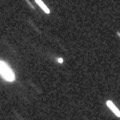
|
Now it is 17.0 mag (June 16, Catalina Sky Survey). It brightened rapidly, and became brighter than originally expected. It keeps 17 mag until 2017. In the Northern Hemisphere, it keeps observable in excellent condition for a long time, although it becomes low temporarily in autumn. It is not observable in the Southern Hemisphere.
Date(TT) R.A. (2000) Decl. Delta r Elong. m1 Best Time(A, h)
July 30 13 1.60 64 29.9 7.679 7.276 63 16.9 18:44 (166,-13)
Aug. 6 13 1.51 63 22.4 7.704 7.276 61 16.9 18:48 (162,-14)
|
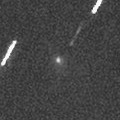
|
Now it is 17.5 mag (June 17, Catalina Sky Survey). It keeps 17-18 mag until autumn. It keeps observable in excellent condition in the Northern Hemisphere. It will be getting lower gradually in the Southern Hemisphere.
Date(TT) R.A. (2000) Decl. Delta r Elong. m1 Best Time(A, h)
July 30 21 45.92 29 10.6 1.515 2.299 129 17.0 1:16 (180, 26)
Aug. 6 21 19.69 32 27.2 1.514 2.307 130 17.0 0:23 (180, 23)
|

|
Now it is 18.4 mag (June 30, C. Jacques, E. Pimentel, J. Barros). It will brighten up to 16 mag and will be observable in good condition in 2017. In 2016, it is observable in excellent condition in the Southern Hemisphere, but it keeps low in the Northern Hemisphere.
Date(TT) R.A. (2000) Decl. Delta r Elong. m1 Best Time(A, h)
July 30 18 47.49 -39 58.1 2.402 3.307 148 17.2 22:13 ( 0, 85)
Aug. 6 18 43.06 -39 35.1 2.432 3.289 141 17.2 21:41 ( 0, 85)
|

|
It brightened up to 13-14 mag from 2014 to 2015. Now it is fading. It has already faded down to 16.6 mag (June 5, Space Surveillance Telescope, Atom Site). It will be observable at 17 mag in 2016.
Date(TT) R.A. (2000) Decl. Delta r Elong. m1 Best Time(A, h)
July 30 23 24.98 -3 25.8 4.686 5.466 136 17.3 2:54 (180, 58)
Aug. 6 23 23.36 -3 45.0 4.661 5.510 143 17.3 2:25 (180, 59)
|

|
It brightened up to 3.7 mag and became a naked eye comet in mid January in 2015 (Jan. 13, Marek Biely). Now it is fading. It has already faded down to 17.1 mag (July 3, Kunihiro Shima). In the Northern Hemisphere, it keeps observable for a long time until the comet fades out. It locates somewhat low in the Southern Hemisphere.
Date(TT) R.A. (2000) Decl. Delta r Elong. m1 Best Time(A, h)
July 30 17 21.37 22 9.6 5.781 6.308 117 17.3 20:47 (180, 33)
Aug. 6 17 18.77 21 13.9 5.905 6.368 112 17.4 20:17 (180, 34)
|

|
It passed only 0.036 a.u. from the earth on Mar. 21-22, and brightened up to 3.9 mag (Mar. 21, Thomas Lehmann). It kept brightening even after the perihelion passage. However, it is fading rapidly now. It has already faded down to 17.1 mag (June 29, Hidetaka Sato). It keeps observable in excellent condition for a while after this both in the Northern Hemisphere and Southern Hemisphere.
Date(TT) R.A. (2000) Decl. Delta r Elong. m1 Best Time(A, h)
July 30 16 48.58 -5 23.5 1.218 1.962 122 17.3 20:15 (180, 61)
Aug. 6 16 54.26 -6 35.9 1.337 2.023 118 18.0 19:53 (180, 62)
|
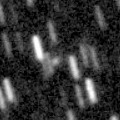
|
Now it is 17.8 mag (June 30, A. Maury, J.-B. de Vanssay, J.-F. Soulier, J.-G. Bosch, T. Noel). It keeps 17 mag for a long time in 2016, and it will be observable in excellent condition in the Southern Hemisphere. It is hardly observable in the Northern Hemisphere.
Date(TT) R.A. (2000) Decl. Delta r Elong. m1 Best Time(A, h)
July 30 3 35.38 -41 57.4 3.271 3.461 92 17.3 5:28 (297, 70)
Aug. 6 3 29.61 -43 20.1 3.204 3.476 97 17.3 5:23 (307, 75)
|
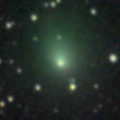
|
It brightened up to 10 mag in 2015 autumn. Now it is appearing in the morning sky. However, it has already faded down to 16.8 mag (June 13, iTelescope Observatory, Siding Spring).
Date(TT) R.A. (2000) Decl. Delta r Elong. m1 Best Time(A, h)
July 30 3 20.88 13 39.5 2.972 2.893 75 17.4 5:28 (205, 38)
Aug. 6 3 26.45 13 51.2 2.916 2.934 81 17.4 5:23 (200, 39)
|

|
First return of a new periodic comet discovered in 2008. Now it is 18.0 mag (July 9, Kunihiro Shima). It keeps observable at 17.5 mag until autumn.
Date(TT) R.A. (2000) Decl. Delta r Elong. m1 Best Time(A, h)
July 30 20 22.25 -18 43.5 2.103 3.117 176 17.5 23:48 (180, 74)
Aug. 6 20 17.56 -18 54.8 2.110 3.110 168 17.5 23:15 (180, 74)
|
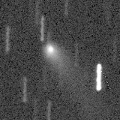
|
It was observed at 14-15 mag from 2014 to 2015. Now it is fading. In the Northern Hemisphere, it keeps observable in excellent condition until winter when the comet will be fainter than 18 mag. It is not observable in the Southern Hemisphere.
Date(TT) R.A. (2000) Decl. Delta r Elong. m1 Best Time(A, h)
July 30 4 5.67 69 36.1 6.094 5.741 65 17.5 5:28 (191,-17)
Aug. 6 4 14.66 70 50.1 6.075 5.781 68 17.5 5:23 (189,-18)
|

|
New comet discovered from the STEREO spacecraft images in May. It brightened up to 8 mag due to the forward scattering. It must be observable high in the evening sky in the Southern Hemisphere. It it not observable in the Northern Hemisphere.
Date(TT) R.A. (2000) Decl. Delta r Elong. m1 Best Time(A, h)
July 30 12 10.16 -14 26.5 1.586 1.423 61 17.5 18:44 (104, 44)
Aug. 6 12 35.60 -15 53.1 1.723 1.524 61 18.0 18:48 (101, 43)
|

|
It will pass the perihelion in 2019. However, it has not been brightening since the discovery in 2010. Now it is 17.6 mag (Dec. 3, D. Buczynski). It keeps observable in excellent condition in the Northern Hemisphere. It is not observable in the Southern Hemisphere.
Date(TT) R.A. (2000) Decl. Delta r Elong. m1 Best Time(A, h)
July 30 4 30.19 53 4.5 10.563 10.070 58 17.6 5:28 (202, -4)
Aug. 6 4 33.35 53 37.7 10.459 10.049 63 17.6 5:23 (199, -3)
|

|
It will brighten up to 13 mag and will be observable in good condition in 2017 summer. In 2016, it keeps observable until winter when it will brighten up to 15.5 mag. It locates somewhat low in the Southern Hemisphere.
Date(TT) R.A. (2000) Decl. Delta r Elong. m1 Best Time(A, h)
July 30 3 41.69 29 45.7 5.027 4.730 67 17.8 5:28 (204, 21)
Aug. 6 3 40.89 30 5.6 4.854 4.679 74 17.6 5:23 (198, 22)
|
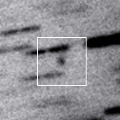
|
Now it is 17.7 mag (June 12, B. Lutkenhoner). It keeps observable at 17.5 mag in good condition from spring to autumn in the Southern Hemisphere. It is not observable in the Northern Hemisphere.
Date(TT) R.A. (2000) Decl. Delta r Elong. m1 Best Time(A, h)
July 30 17 34.13 -62 7.1 4.313 4.979 126 17.6 21:01 ( 0, 63)
Aug. 6 17 33.45 -61 23.5 4.364 4.976 121 17.7 20:33 ( 0, 64)
|

|
It was observed as bright as 13-14 mag for a long time from 2011 to 2014. Now it is fading. It is observable in excellent condition in the Southern Hemisphere. It locates extremely low in the Northern Hemisphere. No observations have been reported since August, 2015.
Date(TT) R.A. (2000) Decl. Delta r Elong. m1 Best Time(A, h)
July 30 17 6.22 -37 34.6 9.112 9.799 130 17.7 20:32 ( 0, 87)
Aug. 6 17 3.19 -37 34.4 9.239 9.834 123 17.7 20:02 ( 0, 87)
|

|
It has brightened in outburst up to 14 mag twice, in 2006 January and 2011 May. It is observable at 17 mag in good condition in autumn.
Date(TT) R.A. (2000) Decl. Delta r Elong. m1 Best Time(A, h)
July 30 1 27.22 7 25.2 5.896 6.222 104 17.9 4:56 (180, 47)
Aug. 6 1 27.96 7 25.1 5.804 6.234 110 17.9 4:29 (180, 47)
|
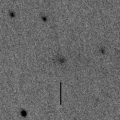
|
Now it is 17.1 mag (July 9, Kunihiro Shima). It was expected to brighten up to 14 mag from winter to summer. But it is much fainter actually. It will be observable in excellent condition in the Southern Hemisphere. It locates low in the Northern Hemisphere.
Date(TT) R.A. (2000) Decl. Delta r Elong. m1 Best Time(A, h)
July 30 16 12.13 -38 36.1 2.485 3.115 119 18.8 19:39 ( 0, 86)
Aug. 6 16 16.56 -38 21.7 2.613 3.167 114 19.0 19:16 ( 0, 87)
|
|
![]()
 9P/Tempel 1
9P/Tempel 1 81P/Wild 2
81P/Wild 2 144P/Kushida
144P/Kushida C/2014 S2 ( PanSTARRS )
C/2014 S2 ( PanSTARRS ) 237P/LINEAR
237P/LINEAR C/2014 W2 ( PanSTARRS )
C/2014 W2 ( PanSTARRS ) 29P/Schwassmann-Wachmann 1
29P/Schwassmann-Wachmann 1 C/2015 TQ209 ( LINEAR )
C/2015 TQ209 ( LINEAR ) 53P/Van Biesbroeck
53P/Van Biesbroeck C/2013 US10 ( Catalina )
C/2013 US10 ( Catalina ) C/2011 KP36 ( Spacewatch )
C/2011 KP36 ( Spacewatch ) C/2015 V2 ( Johnson )
C/2015 V2 ( Johnson ) 118P/Shoemaker-Levy 4
118P/Shoemaker-Levy 4 (3200) Phaethon
(3200) Phaethon C/2015 T4 ( PanSTARRS )
C/2015 T4 ( PanSTARRS ) C/2016 A8 ( LINEAR )
C/2016 A8 ( LINEAR ) 77P/Longmore
77P/Longmore 116P/Wild 4
116P/Wild 4 146P/Shoemaker-LINEAR
146P/Shoemaker-LINEAR C/2015 ER61 ( PanSTARRS )
C/2015 ER61 ( PanSTARRS ) C/2015 WZ ( PanSTARRS )
C/2015 WZ ( PanSTARRS ) 339P/2016 N1 ( McNaught )
339P/2016 N1 ( McNaught ) C/2015 O1 ( PanSTARRS )
C/2015 O1 ( PanSTARRS ) C/2016 B1 ( NEOWISE )
C/2016 B1 ( NEOWISE ) C/2014 W11 ( PanSTARRS )
C/2014 W11 ( PanSTARRS ) 56P/Slaughter-Burnham
56P/Slaughter-Burnham C/2014 OE4 ( PanSTARRS )
C/2014 OE4 ( PanSTARRS ) C/2016 N4 ( MASTER )
C/2016 N4 ( MASTER ) 219P/LINEAR
219P/LINEAR 226P/Pigott-LINEAR-Kowalski
226P/Pigott-LINEAR-Kowalski C/2014 A4 ( SONEAR )
C/2014 A4 ( SONEAR ) C/2014 R3 ( PanSTARRS )
C/2014 R3 ( PanSTARRS ) C/2016 K1 ( LINEAR )
C/2016 K1 ( LINEAR ) 47P/Ashbrook-Jackson
47P/Ashbrook-Jackson C/2012 F3 ( PanSTARRS )
C/2012 F3 ( PanSTARRS ) C/2014 Q2 ( Lovejoy )
C/2014 Q2 ( Lovejoy ) 252P/LINEAR
252P/LINEAR C/2015 B2 ( PanSTARRS )
C/2015 B2 ( PanSTARRS ) 22P/Kopff
22P/Kopff 340P/2016 N2 ( Boattini )
340P/2016 N2 ( Boattini ) C/2014 N3 ( NEOWISE )
C/2014 N3 ( NEOWISE ) P/2016 J3 ( STEREO )
P/2016 J3 ( STEREO ) C/2010 U3 ( Boattini )
C/2010 U3 ( Boattini ) C/2015 VL62 ( Lemmon-Yeung-PanSTARRS )
C/2015 VL62 ( Lemmon-Yeung-PanSTARRS ) C/2015 H2 ( PanSTARRS )
C/2015 H2 ( PanSTARRS ) C/2010 S1 ( LINEAR )
C/2010 S1 ( LINEAR ) 174P/(60558) 2000 EC98 ( Echeclus )
174P/(60558) 2000 EC98 ( Echeclus ) C/2014 Y1 ( PanSTARRS )
C/2014 Y1 ( PanSTARRS )![]()









































